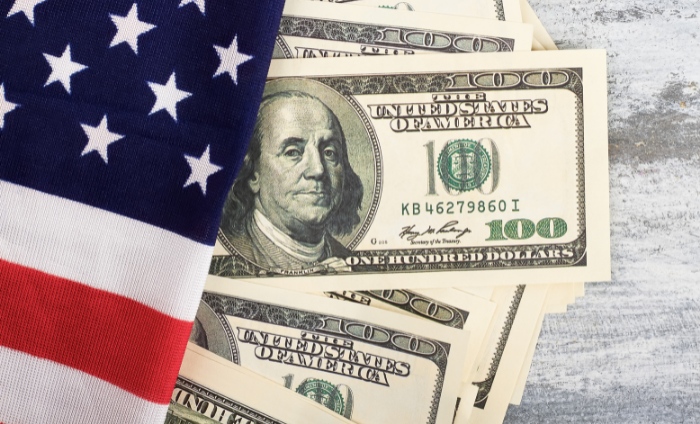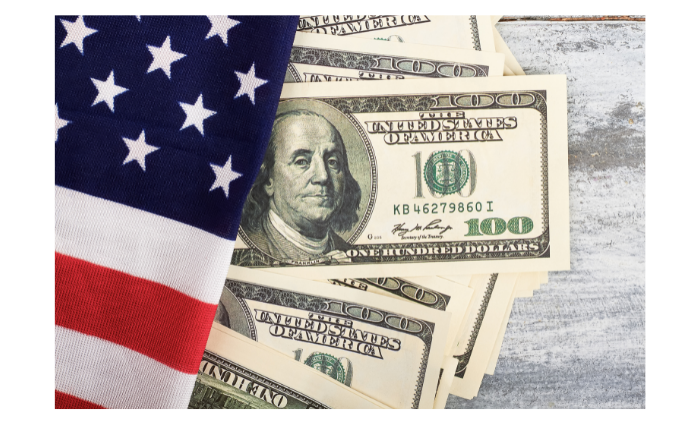Rising interest rates and fears of a recession cast a shadow over growth stocks throughout the year, with brief rallies met consistently by further rates increases and persistent inflation. Even strong fundamental performance was generally ignored as valuations compressed from historic highs.
In this environment, many consumer cyclical companies saw their share prices fall as investors started building a recession into their forecasts. Long-standing market darlings, namely technology companies, also saw their valuations come quickly back to earth.
Pembroke’s US portfolios benefitted to some degree from their industry diversification and the strong performance of a select few holdings. The portfolios are characterized by their faster-than-market growth rates in revenue and earnings, high returns on capital, strong balance sheets and shareholder-aligned management teams.
These factors give the Pembroke investment team confidence in the US portfolios’ upside potential from current levels.
US Growth Fund
Pembroke’s US Growth Fund rose in the fourth quarter of 2022, trading largely in line with the Russell 2000 index. Over the course of 2022, both relative and absolute performance was challenged in a reversal of 2021’s strong results.
Two stocks that made positive contributions to returns of the Fund over the past 12 months
The shares of CRA International (“CRAI”), a leading global consulting firm, rallied in the fourth quarter of 2022, as investors responded to strong earnings and profit performance, as well as to increase guidance in the third-quarter report. The shares sold off in early 2022 when the business adjusted to a different rhythm post-pandemic, with expenses rising slightly and CRAI consultants starting to take vacations again, thereby reducing billable hours. The business has shown impressive resiliency during the current economic slowdown, and growth has come from a balance of organic initiatives and talent acquisition. The company has been very shareholder-friendly, with over 50% of operating income returned to shareholders through dividends and share buybacks in most years. The shares remain attractive for the long term and continue to trade at a discount to peers, despite superior operating performance.
Shares in Globus Medical (“GMED”), which develops and sells components used in spine surgery, performed admirably given the negative equity market backdrop. Clearly, the company’s products are non-discretionary to a certain degree. While COVID led to some surgical delays, patients are generally forced to eventually treat their ailments. Globus has also leveraged its successful foray into surgical robots to take market share from less innovative incumbents. Management continues to launch new and exciting products that should position it to grow at a much faster rate than the overall spine market. Globus is also entering the trauma market, which could represent a significant new leg of growth, and one day rival the spine business in terms of size and profitability. With a large owner steering the company and its capital allocation decisions, the company enjoys market-leading profit margins, a strong balance sheet and a careful acquisition strategy. Near-term risks are mainly tied to a potential slowdown in demand for Globus’ novel robotic technologies if a recession takes hold. Nevertheless, the multi-year outlook remains unchanged.
Two stocks that made negative contributions to returns of the Fund over the past 12 months
Chart Industries (“GTLS”) spent much of 2022 as a top-performing stock for our US growth strategies. In fact, prior to its ill-advised acquisition of Howden Group announced on November 9, 2022, GTLS was up 50% for the year. Investor response to the proposed deal was severe and swift. The stock declined 52% from that November 9 high and ended the quarter down 37%. While this move might seem extreme, we believe the market has it right. This acquisition, expected to close during the first half of 2023, will leave GTLS with irresponsible debt levels, particularly given the macroeconomic backdrop. The company is spending $4.4 billion on an asset of moderate quality that necessitates additional equity (at now materially lower prices), brings excessive debt (above five-time leverage at close) and will require significant management bandwidth. The margin for error is now low, the execution risk is high, and the team is distracted at a time when they should have focused on their plentiful growth opportunities. As such, we sold our position following the acquisition and reallocated the capital.
Shares in Omnicell (“OMCL”), a provider of pharmacy and medication management automation solutions for healthcare facilities, declined in the fourth quarter of 2022. Following an upbeat analyst day held in September of 2022, which was focused on its fast-growing Advanced Services solutions, management threw investors a curve ball when, at the end of September, it reported third-quarter earnings and disclosed a sudden and unexpected deterioration of the hospital pharmacy market. While Omnicell’s competitive positioning appears unchanged, the rapidly shifting environment forced the company to retract its long-term growth targets, reduce its short-term profitability expectations and lay off 9% of is workforce. Omnicell executives described the operating environment as unprecedented, citing elongated sales cycles, capital budget freezes and postponed implementations. We believe these headwinds are unlikely to resolve rapidly as hospitals continue to tighten their belts. However, we may be willing to reconsider our decision in the future given the company’s compelling product suite and leadership position.
Concentrated Fund
In 2022, the Pembroke Concentrated Fund (“PCF”) declined in absolute terms along with the market, as a combination of inflation, interest rate, geopolitical and recession fears pressured financial assets globally. While 2022 disappointed in both absolute and relative terms, the fourth quarter represented PCF’s third straight quarter of relative outperformance when compared to the Russell 2000 benchmark (“R2000”). That being said, the PCF is trailing the Russell over the prior twelve-month period.
Two stocks that made positive contributions to returns of the Fund over the past 12 months
Shares in Stoneridge Inc. (“SRI”) gained over 9% in 2022 compared to a greater than 20% decline in the Russell 2000 benchmark. Following a challenging 2021 for SRI, during which supply chain constraints limited production and boosted costs, the company was able in 2022 to both grow production and sufficiently raise price, so that earnings before interest, taxes, depreciation and amortization (EBITDA) should grow around 60%, compared to a decline of about 40% in 2021. SRI has executed well during the pandemic, and our original thesis remains intact. Specifically, the company’s differentiated exposure to secularly growing auto and truck technology should enable growth well in excess of its end markets, while consistently expanding margins and returns. We remain optimist about its product cycle particulars and foresee multiple years of solid growth as vastly depleted inventories normalize.
Shares in Albany International (“AIN”) returned over 12% in 2022 compared to a greater than 20% decline in the Russell 2000 benchmark. The company’s leading position in machine clothing continued to yield sizable and stable free cash flow generation, while its commercial aerospace business—depressed by the pandemic and Boeing 737 MAX production-related issues—posted several quarters of sequential improvement. Importantly, the aerospace recovery remains in the early phases, and should drive solid growth in the coming years. Furthermore, the company’s differentiated technology continues to win market share on existing commercial and defence platforms, and position the company well for future platforms. As such, AIN remains a core holding in both the Concentrated Fund and our US Growth Fund.
Two stocks that made negative contributions to returns of the Fund over the past 12 months
Chart Industries (“GTLS”) spent much of 2022 as a top-performing stock for our US growth strategies. In fact, prior to its ill-advised acquisition of Howden Group announced on November 9, 2022, GTLS was up 50% for the year. Investor response to the proposed deal was severe and swift. The stock declined 52% from that November 9 high and ended the quarter down 37%. While this move might seem extreme, we believe the market has it right. This acquisition, expected to close during the first half of 2023, will leave GTLS with irresponsible debt levels, particularly given the macroeconomic backdrop. The company is spending $4.4 billion on an asset of moderate quality that necessitates additional equity (at now materially lower prices), brings excessive debt (above five-time leverage at close) and will require significant management bandwidth. The margin for error is now low, the execution risk is high, and the team is distracted at a time when they should have focused on their plentiful growth opportunities. As such, we sold our position following the acquisition and reallocated the capital.
Shares in Paycom, Inc. (“PAYC”) declined 25% in 2022, compared to a 20% decline in the Russell 2000 benchmark. While the results for the fourth quarter of 2022 are not yet announced, Paycom is expected to grow revenue and earnings per share (EPS) for the year by 30% and 32% respectively, while posting returns on equity and invested capital in the mid to high 20s. Furthermore, the company has continued to launch new products, open sales offices and execute well on its growth strategy. From a fundamental perspective, 2022 was not disappointing. That did not stop investors from compressing the company’s multiple and increase its discount rate, as fears of inflation and a persistent high interest rate environment pressured valuations across the broader software and growth sectors. That being said, Paycom remains one of our highest quality and highest conviction names going into 2023.
Other Articles Of Interest
Disclaimer
This report is for the purpose of providing some insight into Pembroke and the Pembroke funds. Past performance is not indicative of future returns. Any securities listed herein, are for informational purposes only and are not intended and should not be construed as investment advice nor is it a recommendation to buy or sell any particular security. Factual information has been taken from sources we believe to be reliable, but its accuracy, completeness or interpretation cannot be guaranteed. Pembroke seeks to ensure that the content of this document is correct and up to date but does not guarantee that the content is accurate and complete and does not assume any responsibility for this. Pembroke is not responsible for decisions or actions taken or made on the basis of information contained in this document.


